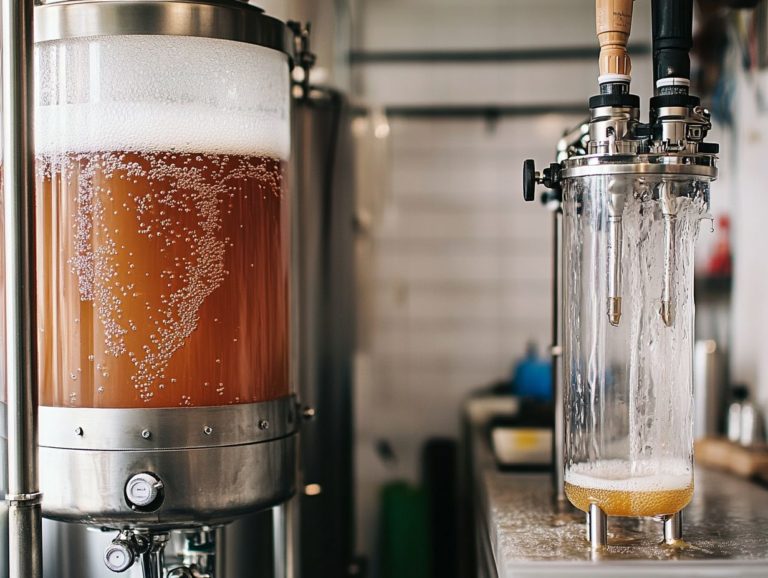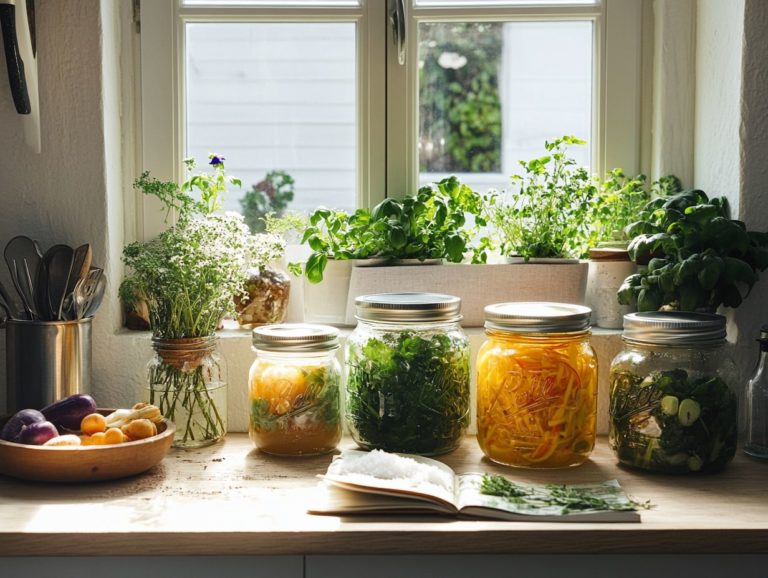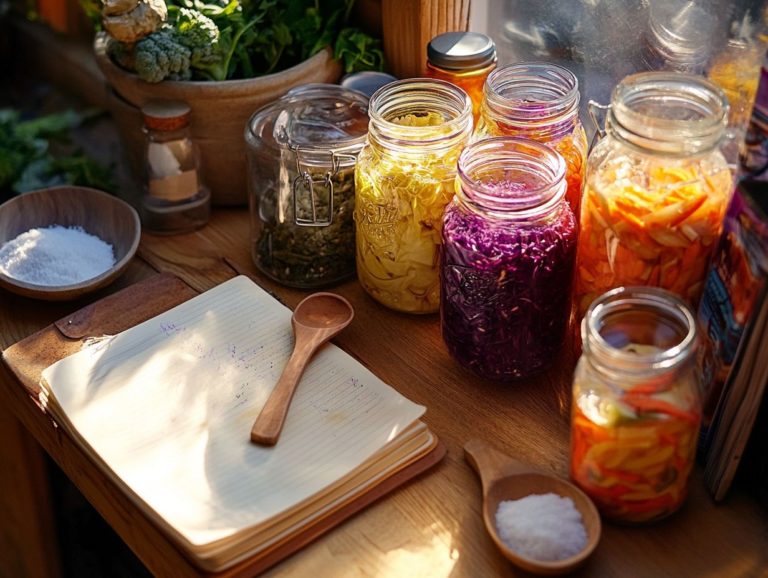Using Fermentation Locks: What You Need to Know
Fermentation is a captivating process that converts simple ingredients into an array of complex flavors. However, your success in this culinary adventure often depends on having the right tools one of which is the fermentation lock, often used in conjunction with a fermentation jar or mason jar.
This article delves into what fermentation locks are, the benefits they offer, and how they function across various fermentation projects, whether you re brewing beer, crafting wine, or fermenting vegetables in a fermentation vessel.
You ll also discover the different types of fermentation locks available, potential risks to be mindful of, essential maintenance tips, and where you can find these tools, such as fermentation kits.
Dive into this exciting exploration to truly elevate your fermentation experience! Learning from fermentation experts and attending fermentation masterclasses can also enhance your skills.
Contents
- Key Takeaways:
- What Are Fermentation Locks?
- Why Use Fermentation Locks?
- How Do Fermentation Locks Work?
- What Types of Fermentation Locks Are Available?
- Water Seals Overview
- How to Use Fermentation Locks in Different Fermentation Processes?
- Fermentation Techniques
- How to Properly Clean and Maintain Fermentation Locks?
- Where Can You Purchase Fermentation Locks?
- Frequently Asked Questions
- What is a fermentation lock and why is it important to use one?
- What types of fermentation locks are available and which one should I use?
- How do I properly clean and maintain my fermentation lock?
- Do I need to fill the fermentation lock with liquid and if so, what should I use?
- At what stage of the fermentation process should I use the fermentation lock?
- What are some common issues with fermentation locks and how can I prevent them?
Key Takeaways:
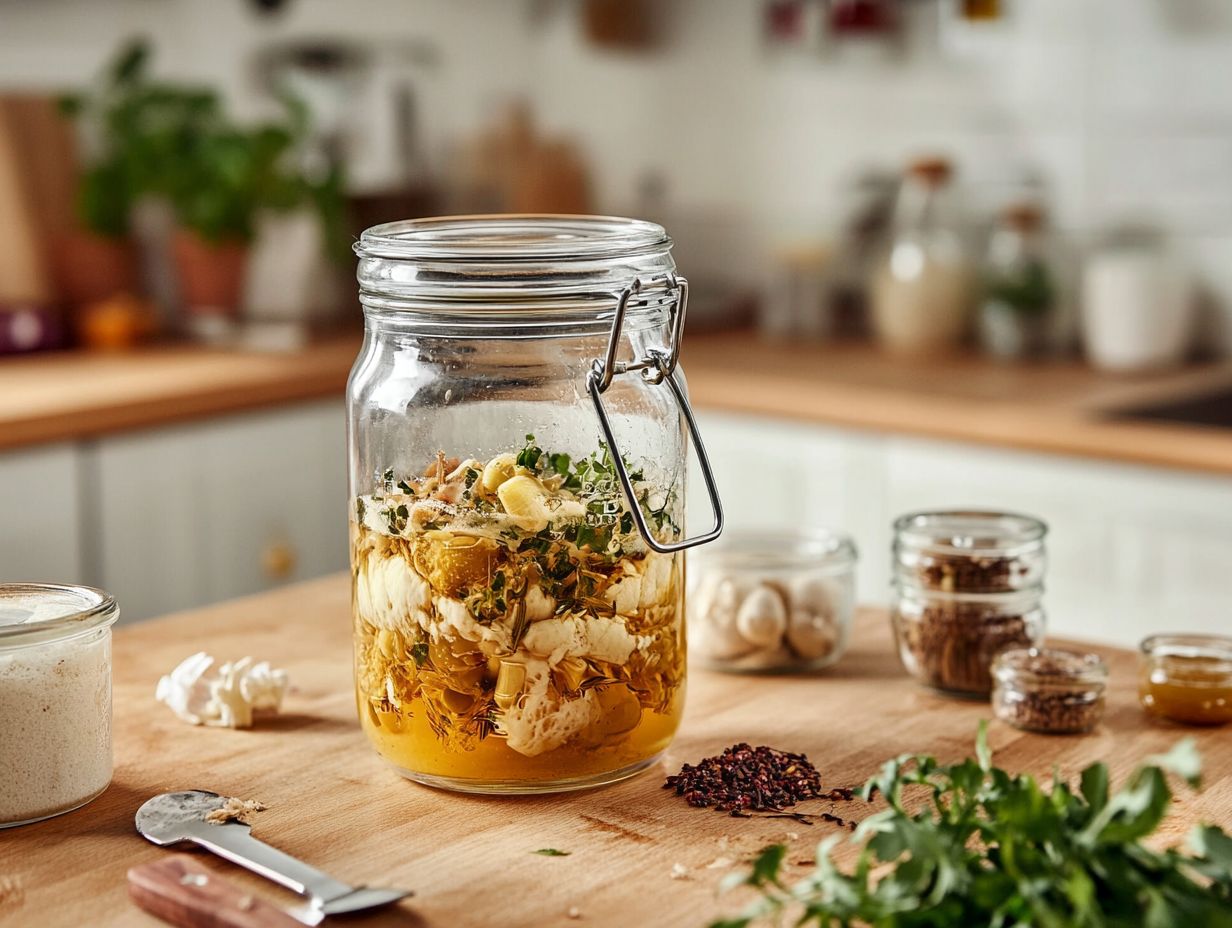
- Using fermentation locks helps prevent contamination and maintain consistent pressure during fermentation.
- There are different types of fermentation locks available, such as airlocks, water seals, and bubbler airlocks, each with their own benefits, including maintaining brine level and facilitating the release of CO2.
- Proper cleaning, such as using vinegar to sterilize, and maintenance of fermentation locks is crucial for successful fermentation and preventing any risks.
What Are Fermentation Locks?
Fermentation locks, often referred to as airlocks, are critical tools in your fermentation journey. These clever devices create an environment without oxygen, allowing gases like carbon dioxide (CO2) to escape while keeping unwanted contaminants at bay. Utilizing a food-grade fermentation lid can also enhance the efficiency of the airlock system.
Whether you re brewing beer, crafting wine, or fermenting vegetables like kimchi and sauerkraut, using an airlock ensures that your fermentation process remains both safe and efficient. By implementing an airlock system, you can maintain the optimal fermentation conditions that are essential for successful lacto-fermentation, food preservation, and for producing delicious, flavorful fermented delights.
Why Use Fermentation Locks?
Employing fermentation locks is essential for anyone diving into the art of fermentation. These handy devices allow gases produced during the process to escape while keeping outside contaminants at bay, thus preserving the integrity of your fermenting medium.
Fermentation locks play a vital role in maintaining a pristine environment, shielding your creations from unwanted bacteria or rogue wild yeasts that could spoil your hard work especially in recipes for brine-based pickles or vibrant fermented vegetables like kimchi and sauerkraut.
By utilizing fermentation locks, you can enhance both the flavor and safety of your fermented products, ensuring a successful and enjoyable fermentation journey.
What Are the Benefits of Using Fermentation Locks in Fermentation?
The benefits of using fermentation locks in your fermentation process are numerous, primarily centered on their remarkable ability to create a stable anaerobic atmosphere that fosters optimal bacterial growth while protecting the integrity of your fermenting medium.
These essential tools play a pivotal role in maintaining a controlled fermentation environment, which is vital for achieving successful results in various processes, from alcohol fermentation to lacto-fermentation and vegetable fermenting, including brine-based pickles and kimchi.
With fermentation locks in place, you can significantly reduce the risk of pressure buildup, leading to a more predictable and safer fermentation experience.
These locks are your first line of defense against contamination from unwanted microorganisms, which could spoil your batch or disrupt the desired fermentation process. They also facilitate the gentle release of gases, essential for avoiding any explosive mishaps that could compromise both the safety and flavor of your ferment.
Enhanced flavor development is another noteworthy advantage. By using fermentation locks, you encourage a consistent environment for beneficial bacteria to thrive, resulting in more complex and robust flavors in your fermented foods, such as sauerkraut and kombucha.
In essence, fermentation locks are not merely a safety feature; they are critical tools that significantly elevate the overall success and quality of your fermentation recipes.
Get started on your fermentation journey today!
How Do Fermentation Locks Work?
Fermentation locks work on a fundamental principle: they allow carbon dioxide (CO2), produced during fermentation, to escape while keeping air and contaminants at bay. These nifty devices make it a breeze to let CO2 escape while keeping your brew safe!
Typically, fermentation locks consist of a straightforward sealed container with a tube or valve that lets the gas bubble out while maintaining stable air pressure in the fermentation vessel. Using weights in the vessel can help keep vegetables submerged to ensure proper fermentation.
The liquid inside the airlock serves as a protective barrier, ensuring that only gases escape. This safeguards the fermenting medium for processes like vegetable fermentation and alcohol production. Clean water is commonly used in the airlock to maintain an effective barrier.
When you delve into the mechanics behind these devices, you quickly realize their importance in brewing and preservation. Take the S-shaped airlock, for example. Its curved tube traps liquid within its bend, creating a physical barrier that blocks unwanted substances while allowing trapped gases to escape.
Then there’s the three-piece airlock, which offers a modular design that makes it easy to clean and monitor fermentation activity. If you’re feeling crafty, you can easily construct DIY airlocks to cater to your specific fermentation needs, adapting seamlessly to different techniques and vessels.
Both types promote effective gas exchange, enabling fermentation to proceed optimally while warding off spoilage. So, no matter the design you choose, fermentation locks provide a controlled environment that ultimately enhances the quality of your final product. Using a fermentation chamber can further control the temperature and humidity for more precise fermentation conditions.
What Types of Fermentation Locks Are Available?
You ll find a variety of fermentation locks at your disposal, each crafted to expertly manage gas release during fermentation while maintaining the integrity of your fermenting environment.
Traditional airlocks serve as a straightforward barrier for CO2 escape, while water seals harness liquid to keep contaminants at bay. If you prefer a bit of flair in your process, bubbler airlocks provide a visual display of gas release through charming bubbles.
For those who desire flexibility, three-piece airlocks offer a more adjustable design.
1. Airlocks
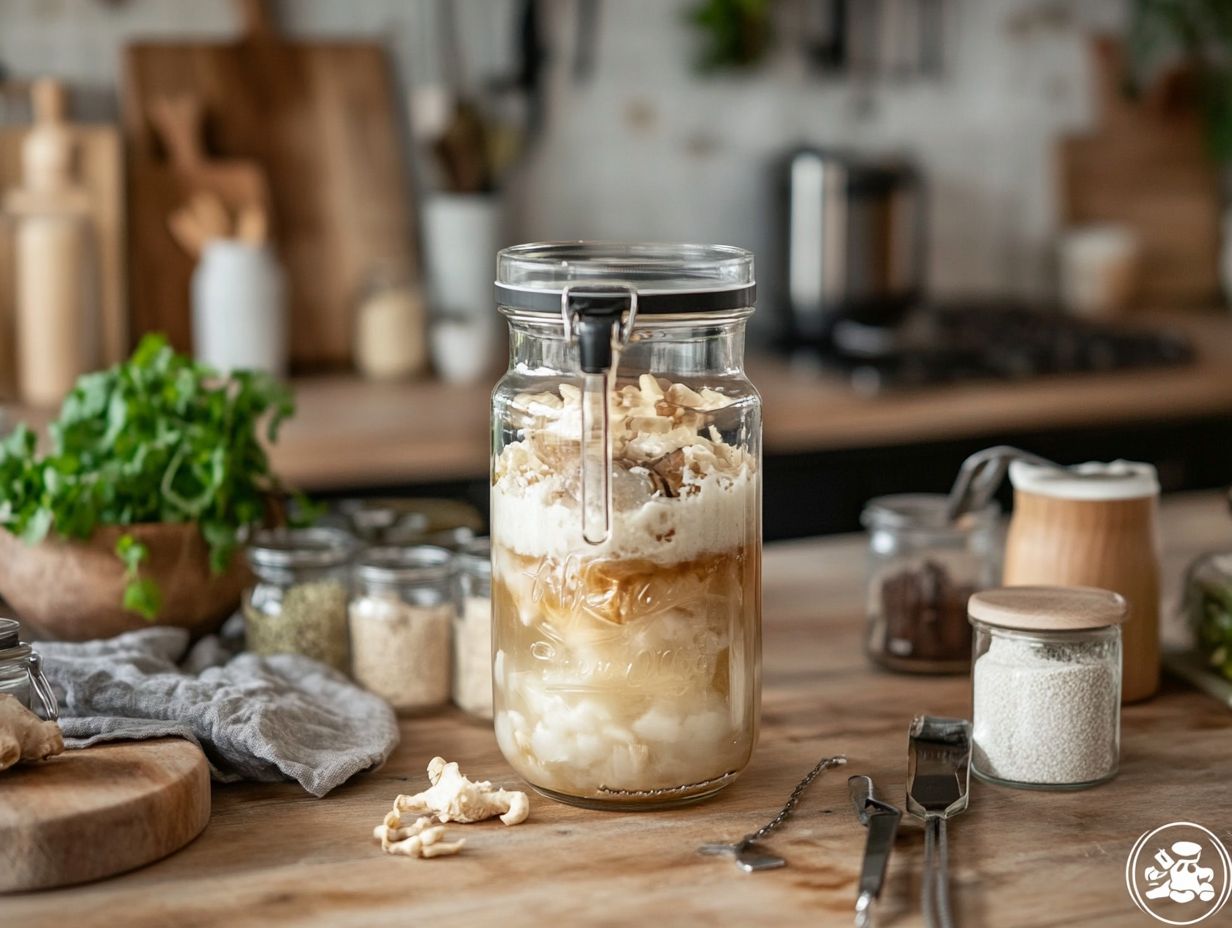
Airlocks are among the most essential tools in your fermentation journey. They provide a simple yet effective way for carbon dioxide (CO2) produced by fermenting yeast or bacteria to escape while preserving that all-important environment without oxygen.
Typically positioned atop fermentation vessels, these devices ensure that no unwelcome outside air contaminates your fermenting medium while simultaneously offering a path for gas release.
The reliable design of airlocks has made them a beloved staple in home brewing and vegetable fermenting. They help create a safer and more controlled fermentation environment.
But airlocks do more than just release gas; their unique construction often involves a liquid or solid barrier that prevents contaminants from sneaking in while letting pressure escape. This clever design promotes a healthy fermentation process, making it easier for you to achieve desirable results.
When compared to other fermentation locks, airlocks significantly reduce the risk of spoilage and unwanted microbial growth, creating optimal conditions for your projects. Their effectiveness shines in various scenarios, such as beer brewing, sauerkraut making, and sourdough cultivation, where a stable anaerobic environment fosters the specific bacteria and yeasts needed to develop those delightful flavors and textures.
By maintaining these ideal conditions, airlocks are crucial in securing successful outcomes and elevating the overall quality of your finished creations. Don t miss out on the benefits of using fermentation locks! They are essential for achieving the best results in your brewing adventures.
Water Seals Overview
2. Water Seals
Water seals offer a sophisticated alternative for creating a fermentation environment without air. They employ a liquid barrier to block external contaminants while allowing gases like CO2 to escape.
The water in these seals acts as a protective shield, generating pressure that prevents air from infiltrating the fermentation vessel. This process facilitates the essential gaseous exchange crucial for successful fermentation. This method is particularly ideal for fermenting vegetables and can elevate the flavor profile of products such as pickles and kimchi by minimizing exposure to unwanted bacteria. Using food-grade glycerine in the water seal can also increase its effectiveness.
In a variety of fermentation scenarios, water seals prove especially advantageous in preserving the distinctive taste and quality of fermented foods. By maintaining a low-oxygen environment, these seals inhibit the growth of mold and other aerobic pathogens that could jeopardize the integrity of your ferment.
The gentle release of carbon dioxide also mitigates the risk of pressure buildup, making this method a safe choice for home fermenters. Using clean water in the seal ensures the barrier remains effective throughout the fermentation process.
Whether you’re brewing hearty sour ales or perfecting your sauerkraut, the effectiveness of water seals ensures a consistent fermentation process. This results in products that are not only safe but also rich in flavor and nutritional value. Leveraging different fermentation techniques can further enhance the quality of your fermented foods.
3. Bubbler Airlocks
Bubbler airlocks have become a favored choice for fermentation enthusiasts, thanks to their ingenious design that provides a clear visual cue for gas release. This makes it effortless for you to monitor the fermentation process. These airlocks not only allow CO2 to escape but also create a liquid barrier that keeps contaminants at bay, ensuring a controlled anaerobic environment.
The transparent chamber lets you witness the bubbling activity, a great indicator of the fermentation’s vitality, particularly in your beer brewing, alcohol fermentation, or when making sauerkraut and pickles.
Using a bubbler airlock makes fermentation easy and enjoyable, allowing even novice brewers to quickly grasp its functionality and advantages. They help maintain a stable fermentation environment by regulating air pressure, significantly diminishing the risk of spoilage from unwanted microorganisms.
These airlocks are incredibly versatile, perfect for a variety of fermentation techniques, including winemaking, cider production, and crafting kombucha. Their effectiveness, combined with the visual feedback they provide, enables you to engage more deeply in the fermentation process.
Experience the joy of fermentation like never before with the versatility of bubbler airlocks! You can use them with fermentation jars, fermentation crocks, and even DIY airlock systems for your various fermentation recipes.
4. Three-Piece Airlocks
Three-piece airlocks present a versatile solution for your fermentation needs. They are crafted to offer customizable functionality that adapts seamlessly to various fermentation conditions. This design typically features a removable top, simplifying the cleaning process and allowing for adjustments throughout fermentation.
These airlocks are ideal for both novice and expert brewers who are keen on mastering different fermentation techniques. With this setup, you can ensure optimal CO2 release while safeguarding against contamination. The flexibility of these airlocks makes them suitable for a wide array of fermentation vessels, whether you’re using mason jars for vegetable fermentation or dedicated crocks for more intricate processes. Ensuring the liquid in the airlock is at the correct level is crucial for maintaining this balance.
Their design strikes a perfect balance between simplicity and effectiveness, enhancing usability for both novice and experienced brewers. The adaptability of three-piece airlocks means they can accommodate diverse fermentation types, whether you re brewing beer, crafting wine, or fermenting kombucha. They are particularly useful for maintaining an anaerobic environment and allowing carbon dioxide to escape efficiently.
As a beginner, you ll find the straightforward assembly and disassembly incredibly convenient. This allows you to monitor your progress without any mess. For the seasoned brewer, the customizable elements provide an opportunity for precision adjustments, elevating the quality and flavor profiles of the final product. Many fermentation kits come equipped with three-piece airlocks to facilitate this process.
In conclusion, three-piece airlocks facilitate a hassle-free fermentation experience, ensuring successful outcomes regardless of your skill level. Their widespread use in fermentation masterclasses and workshops underscores their reliability and versatility.
How to Use Fermentation Locks in Different Fermentation Processes?
Beer Brewing
Utilizing fermentation locks with precision can greatly elevate the success of your fermentation endeavors, whether you’re diving into beer brewing, wine making, or vegetable fermentation.
These locks are important in different fermentation methods, such as lacto-fermentation, a method that uses beneficial bacteria to preserve and enhance the flavor of your fermented vegetables.
Wine Making
While the application of these locks may vary based on your chosen fermentation method, their core purpose remains unwavering: to create an anaerobic environment while permitting carbon dioxide (CO2) to escape safely. Whether you’re using a fermentation lid or a more traditional S-shaped airlock, maintaining a stable environment is crucial.
Vegetable Fermentation
When you’re fermenting vegetables in a mason jar or crafting your next batch of kombucha, mastering the integration of fermentation locks into your process will not only enhance flavor but also safeguard against unwanted contamination. Properly sterilizing your equipment and using food-grade materials, like food-grade glycerine, can significantly reduce risks.
Fermentation Techniques
1. Beer Brewing
In beer brewing, fermentation locks are essential for managing the fermentation process. They allow carbon dioxide (CO2) to escape while preventing unwanted air, protecting your brew from contamination.
Attach an airlock to your fermentation vessel once the wort has cooled and received its yeast inoculation. This ensures an anaerobic environment ideal for yeast activity.
Keeping an eye on bubbling activity is imperative. This bubbling indicates that fermentation is underway.
Each fermentation vessel may have different bubbling rates influenced by yeast health and wort composition. If you notice irregular bubbling, it might be time for adjustments.
Ensure the temperature is right for the yeast strain you re using. Other factors like nutrient levels and sanitation also play vital roles.
Sanitation is crucial at every stage to prevent contamination. Thoroughly clean and sanitize all equipment before starting.
Maintaining a stable fermentation environment, free from drastic temperature swings, is essential for consistent and high-quality results.
2. Wine Making
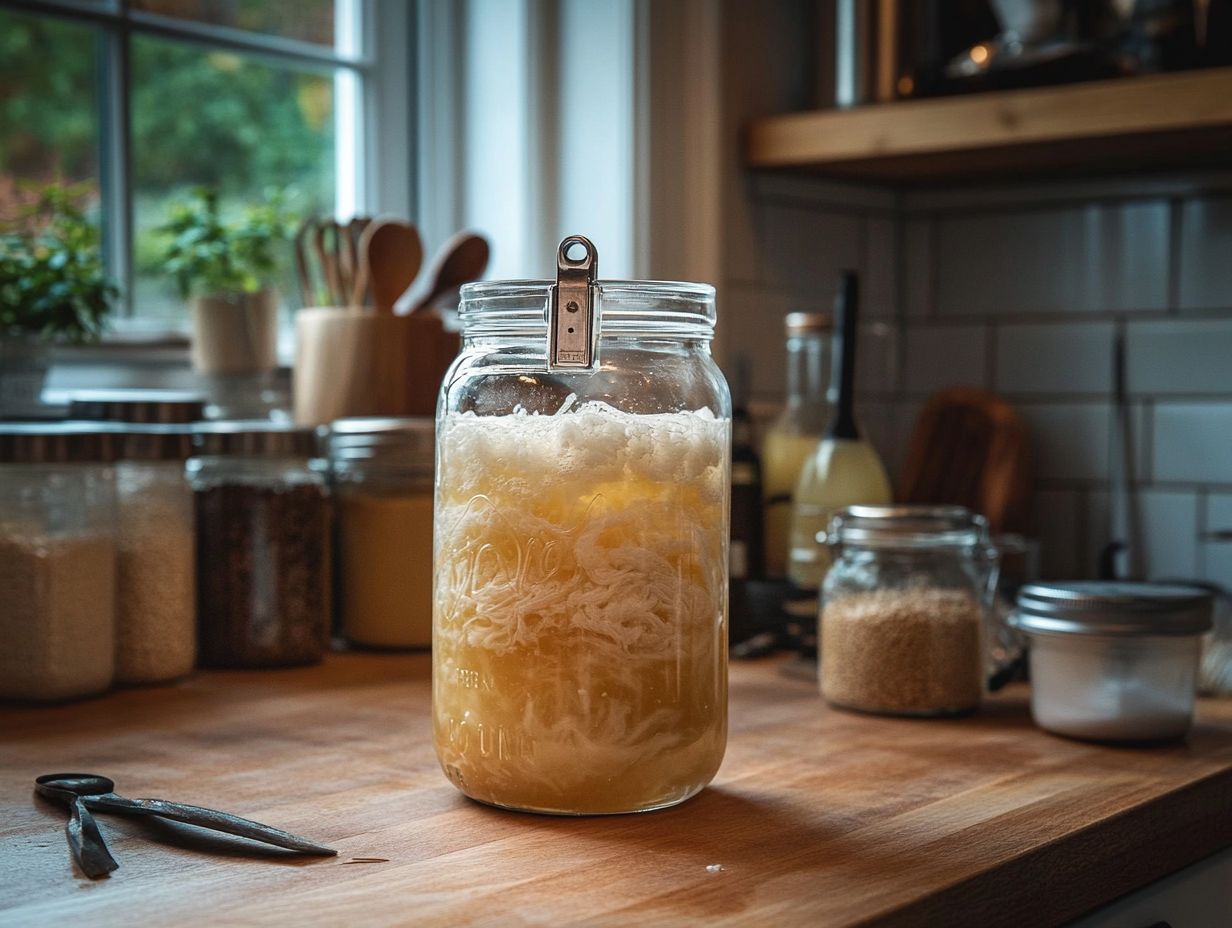
In winemaking, fermentation locks are key for a seamless fermentation process. They allow carbon dioxide (CO2) to escape while protecting the must.
Once you crush the grapes and add yeast, install the fermentation lock. This step creates an anaerobic environment vital for proper fermentation.
The fermentation lock helps regulate temperature and pressure, minimizing spoilage risks from wild yeasts and bacteria. Using weights can help keep the grape must submerged.
Regularly check the fermentation lock for bubbles; this indicates fermentation is active. Maintaining the water level is also crucial.
If issues arise, adjust the temperature or nutrient levels in the must to preserve flavor integrity. S-shaped airlocks are particularly good for monitoring fermentation progress.
Different types of fermentation locks, like airlocks and blow-off tubes, serve specific purposes based on your batch size and vigor of fermentation.
Incorporating temperature control systems and conducting periodic sampling can enhance the quality of your wine, leading to a more refined final product.
3. Vegetable Fermentation
Vegetable fermentation thrives when you use fermentation locks. These handy tools create an environment without oxygen, which is essential for nurturing beneficial bacteria while keeping harmful microorganisms at bay. When fermenting vegetables like sauerkraut or kimchi, submerge them in a brine and fit a fermentation lock onto the jar. This setup allows carbon dioxide (CO2) to escape, preserving the vegetables and enhancing their flavor through a masterful controlled fermentation process.
To kick things off, prepare your brine by mixing the right amount of salt with water, ensuring it’s fully dissolved. The salt concentration is key to creating the optimal environment for fermentation. Using food-grade salt is recommended to avoid any unwanted additives.
Next, fill your jars with the brined vegetables, making sure to leave enough headspace for expansion during fermentation. Once the jars are sealed with fermentation locks, watch the bubbles in the fermentation lock. This is a reassuring way to confirm that gas is escaping as it should.
Maintaining the brine level is crucial; if it dips below the vegetables, spoilage could become a concern. If needed, simply top it off with more brine to ensure you achieve the best possible results. Monitoring the liquid level in the airlock is also vital to maintain the anaerobic conditions necessary for successful fermentation.
Are There Any Risks of Using Fermentation Locks?
While fermentation locks are critical tools in your fermentation journey, it’s important to recognize the potential risks that can influence the final outcome. For instance, monitor the brine level in your fermentation jar to prevent air exposure, which could lead to contamination.
Issues such as contamination from external sources, blockages in the airlock mechanism, and fluctuating pressure levels can all result in less-than-desirable fermented products. By understanding these potential challenges, you can take proactive steps to ensure a thriving fermentation environment that yields the best results.
1. Contamination
Contamination poses a significant risk when using fermentation locks. Even the tiniest breach in the anaerobic environment can introduce unwanted bacteria or wild yeast into your fermentation vessel. This can harm the flavor and safety of your final product, especially when you’re dealing with delicate flavors in vegetable fermentation or brewing. To mitigate this risk, regularly inspect the integrity of your fermentation lock.
Beyond ensuring that the lock is properly sealed, be mindful of common sources of contamination. These include unclean utensils, contaminated ingredients, and exposure to the environment during fermentation. Implementing strict sanitation practices is crucial. This means thoroughly cleaning and sanitizing all equipment before use and working in a pristine space to minimize the chance of cross-contamination. Using food-grade glycerine in your fermentation lock can help maintain the integrity of your fermentation environment.
Keep your ferments away from fruits or other items that might harbor wild yeast. By prioritizing these preventive measures, you can protect your fermentation efforts and consistently achieve high-quality results. Using weights to keep the fermenting vegetables submerged in brine can also help prevent contamination.
Don t wait! Start fermenting today for the best flavors that your vegetables can offer!
2. Blockages and Pressure Build-Up
Blockages in fermentation locks can pose a serious risk by hindering the escape of carbon dioxide (CO2). This may cause the lock to malfunction or even break the vessel, particularly during vigorous fermentation when gas production is at its peak.
It s essential to perform regular checks and maintenance on your fermentation lock and airlock system to ensure they function properly and prevent any potential blockages.
Several factors can contribute to these blockages, with sediment buildup being a primary concern. As fermentation progresses, yeast and other particulates can settle and obstruct the lock, impeding gas escape. Improper installation can also compromise the lock’s effectiveness, as loose fittings may allow gas to escape externally rather than through the designated path.
Additionally, fluctuating air pressure and improper brine levels can exacerbate these issues, particularly in brine-based fermentations like pickles and sauerkraut.
To troubleshoot, inspect the fermentation lock for any sediment accumulation and clean it regularly, ensuring a snug seal without overtightening. Ensure gases escape efficiently and bubbles exit smoothly through the airlock. By following these simple maintenance steps and keeping the brine level consistent, you can significantly enhance fermentation efficiency while ensuring safety.
3. Inconsistent Pressure
Inconsistent pressure within fermentation locks can throw a wrench in your fermentation efforts, leading to poor outcomes. Fluctuations in pressure may disrupt the process, possibly resulting in off-flavors, incomplete fermentation, or even spoilage.
That s why it’s crucial to keep a close eye on the fermentation lock and ensure it s functioning optimally to maintain a stable low-oxygen environment. Using a fermentation chamber can help manage these variations effectively.
Several factors could be responsible for these inconsistencies, such as temperature fluctuations and improper sealing, which can hinder the lock s ability to sustain consistent pressure levels. For example, if the temperature of your fermentation area swings dramatically, it can impact the gas production rate from yeast activity, worsening these pressure issues. Using weights to keep vegetables submerged in brine can also help maintain consistency.
To combat this, consider using temperature-controlled environments that create a more stable atmosphere. Ensure that your fermenter is properly sealed to mitigate any airflow disruptions, allowing your fermentation process to thrive without the risk of unwanted oxidation. It’s advisable to check for cracks and wear in the grommet and other fittings.
How to Properly Clean and Maintain Fermentation Locks?
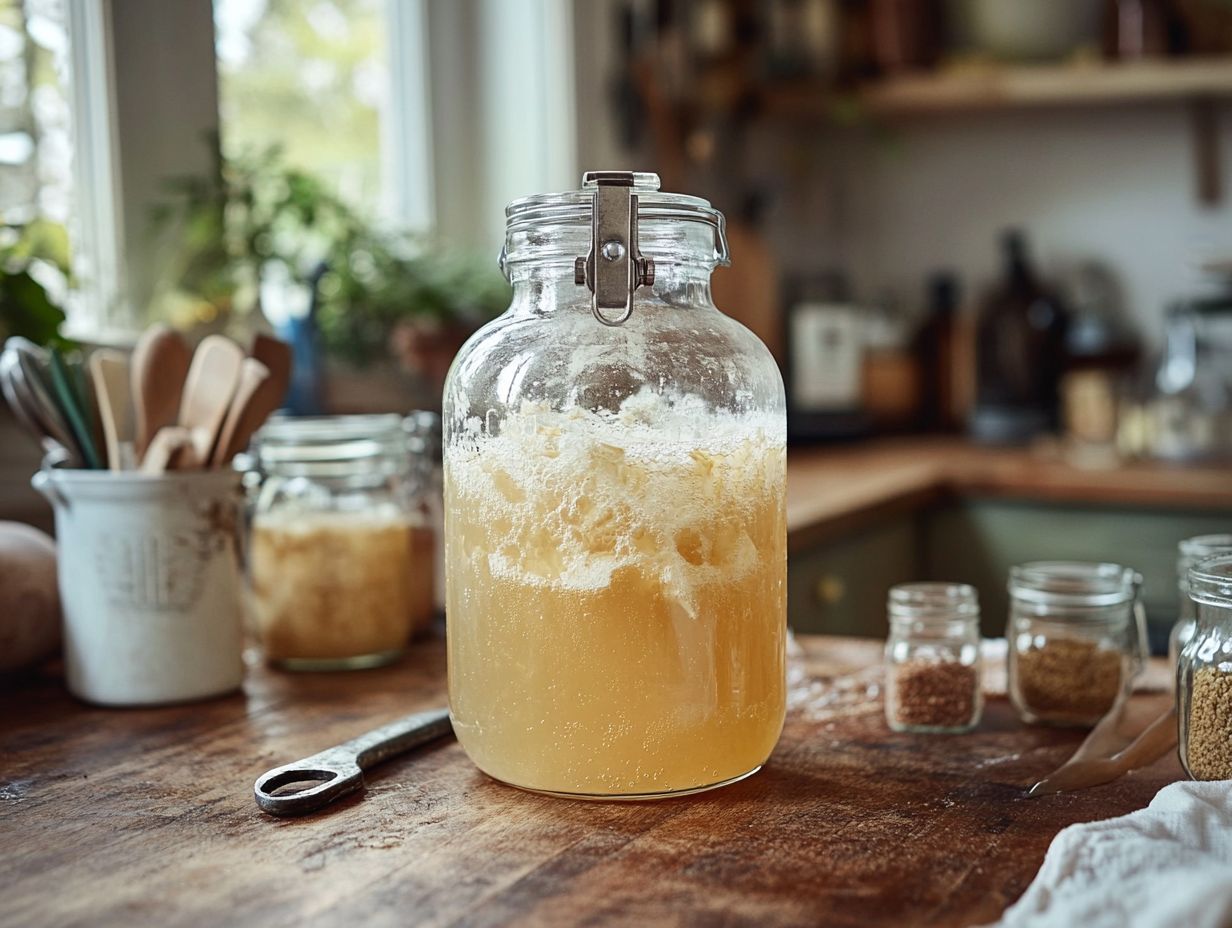
Cleaning and maintaining your fermentation locks is key to their success! Proper cleaning and maintenance help prevent contamination and guarantee successful outcomes in both food preservation and alcohol fermentation.
By regularly sanitizing with food-grade cleaning agents and food-grade glycerine, you can eliminate any residual yeast or bacteria, maintaining a pristine fermentation environment that supports optimal performance.
Sticking to a routine cleaning schedule will keep your fermentation locks in pristine condition for repeated use.
To clean fermentation locks effectively, begin by disassembling the lock and rinsing each part in warm water. Use a gentle, non-abrasive sponge to scrub away any particles, and then soak the components in a solution of clean water and food-safe sanitizer. Don’t skip rinsing! Thoroughly remove any sanitizer residue to ensure your next batch thrives.
After cleaning, take a moment to inspect the locks for cracks or signs of wear that could compromise their function in future fermentations.
Once everything is dry, store the locks in a clean, dry location to prevent dust or bacteria from settling, ensuring they are primed and ready for your next fermentation project. This is particularly important when fermenting vegetables like kimchi and kraut, which require a fermentation jar or fermentation crock for best results.
Where Can You Purchase Fermentation Locks?
You can find fermentation locks from a variety of sources, perfect for both novice and experienced fermenters who want to elevate their fermentation game. Local homebrew supply stores typically carry fermentation kits that come with airlocks. Numerous online retailers boast an extensive selection, ranging from basic airlocks to specialized kits tailored for wine making, beer brewing, and vegetable fermentation.
This accessibility helps you find the right fermentation tools easily. You might also discover DIY airlock solutions that can be customized for specific fermentation techniques.
Don’t forget general stores. Also, consider specialized shops like organic markets or farm supply stores, as they often stock fermentation accessories. These places might also offer fermentation classes taught by experts who can provide valuable insights into creating the perfect fermentation environment.
When you’re shopping, it’s crucial to consider the specific requirements of your fermentation project. The type of beverage or food you re fermenting can dictate the most suitable lock to use. For example, a three-piece airlock or S-shaped airlock might be ideal for different kinds of ferments. Being selective ensures that optimal conditions are maintained throughout the fermentation process, significantly impacting flavor development and consistency in your final product.
By choosing a lock that aligns with your unique fermentation goals, you can effectively encourage the desired microbial activity while keeping unwanted contaminants at bay.
Watch this tutorial on using fermentation locks!
Frequently Asked Questions
What is a fermentation lock and why is it important to use one?
A fermentation lock, also known as an airlock, is a device used in fermentation to allow gas to escape while preventing outside air from entering the container. This is important because it creates an oxygen-free environment, which is necessary for the fermentation process to occur properly. Keeping the liquid in the airlock at appropriate levels is also essential for maintaining this atmosphere.
What types of fermentation locks are available and which one should I use?
There are various types of fermentation locks available, such as three-piece airlocks, S-shaped airlocks, and water-sealed airlocks. The type you should use depends on personal preference and the type of fermentation being done. For fermenting vegetables or making kombucha, specific types of airlocks might be more suitable. However, water-sealed airlocks are generally considered the most effective and reliable option.
How do I properly clean and maintain my fermentation lock?
To clean your fermentation lock, disassemble all parts and wash them with hot, soapy water before rinsing and drying them thoroughly. You can also use vinegar for an extra cleaning boost. It is important to regularly check and clean the airlock to prevent clogs and ensure proper function. Store the lock in a clean, dry place when not in use.
Do I need to fill the fermentation lock with liquid and if so, what should I use?
Yes, it is important to fill the fermentation lock with liquid to create a seal and prevent outside air from entering. You can use water, sanitizer solution, or even vodka as the liquid. Just make sure to refill as needed to keep the liquid at the recommended level. Using food-safe liquids like food-grade glycerine can also be an option.
At what stage of the fermentation process should I use the fermentation lock?
Fermentation locks should be used during the primary fermentation stage, when the yeast is actively converting sugars into alcohol and carbon dioxide. This is especially critical for alcohol fermentation and fermenting spirits. Once the primary fermentation is complete, you can remove the lock and use a solid stopper or cap for storage.
What are some common issues with fermentation locks and how can I prevent them?
Clogs and leaks are the most common issues with fermentation locks. To prevent clogs, make sure to regularly clean and monitor the lock. To prevent leaks, properly seal the fermentation vessel and check for any cracks or damage in the fermentation lock itself. Don’t wait until it’s too late regularly clean your fermentation lock to prevent clogs!
Ready to start fermenting? Choose your lock and let the fun begin!

